Telecommunications Business Environment: A Vodafone Case Study Report
VerifiedAdded on 2020/05/11
|14
|2919
|253
Report
AI Summary
This report provides a comprehensive analysis of Vodafone's telecommunications business environment. It begins with an introduction to telecommunications and its infrastructure, focusing on Vodafone as a case study. The report delves into infrastructure providers and types of service provisions offered by Vodafone. Task 2 examines the key features of the telecommunications retail industry, the current business environment, and Vodafone's retail business strategy, service provision, and billing structure. Task 3 investigates products developed for telecommunication networks and discusses the business and operational benefits of future trends. Finally, Task 4 explains Quality of Service (QoS) in telecommunications, methods for measuring QoS, and the role of the regulator in service provisioning and accessibility, concluding with a summary of the findings. The report covers various aspects, including political, economic, social, and technological factors impacting the company.
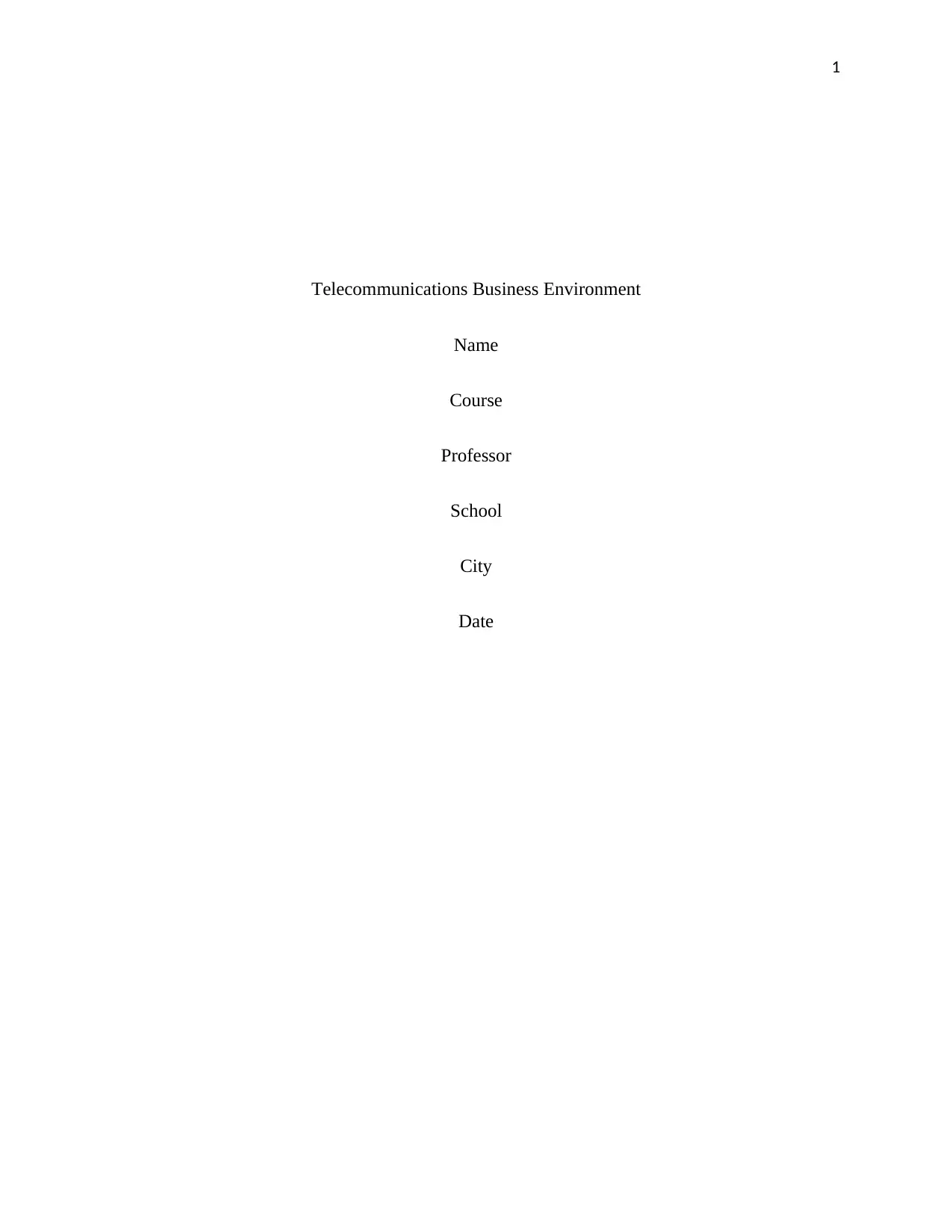
1
Telecommunications Business Environment
Name
Course
Professor
School
City
Date
Telecommunications Business Environment
Name
Course
Professor
School
City
Date
Paraphrase This Document
Need a fresh take? Get an instant paraphrase of this document with our AI Paraphraser
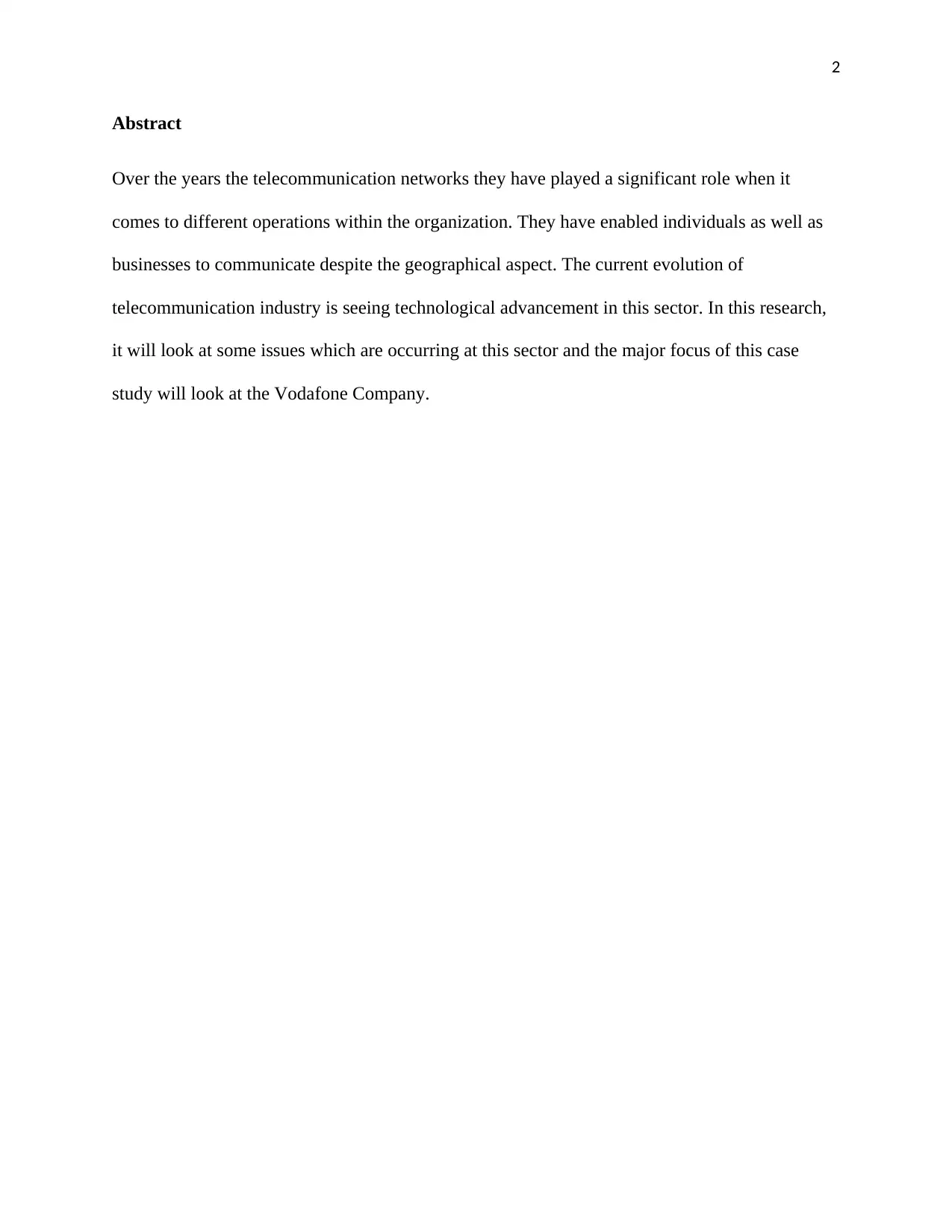
2
Abstract
Over the years the telecommunication networks they have played a significant role when it
comes to different operations within the organization. They have enabled individuals as well as
businesses to communicate despite the geographical aspect. The current evolution of
telecommunication industry is seeing technological advancement in this sector. In this research,
it will look at some issues which are occurring at this sector and the major focus of this case
study will look at the Vodafone Company.
Abstract
Over the years the telecommunication networks they have played a significant role when it
comes to different operations within the organization. They have enabled individuals as well as
businesses to communicate despite the geographical aspect. The current evolution of
telecommunication industry is seeing technological advancement in this sector. In this research,
it will look at some issues which are occurring at this sector and the major focus of this case
study will look at the Vodafone Company.
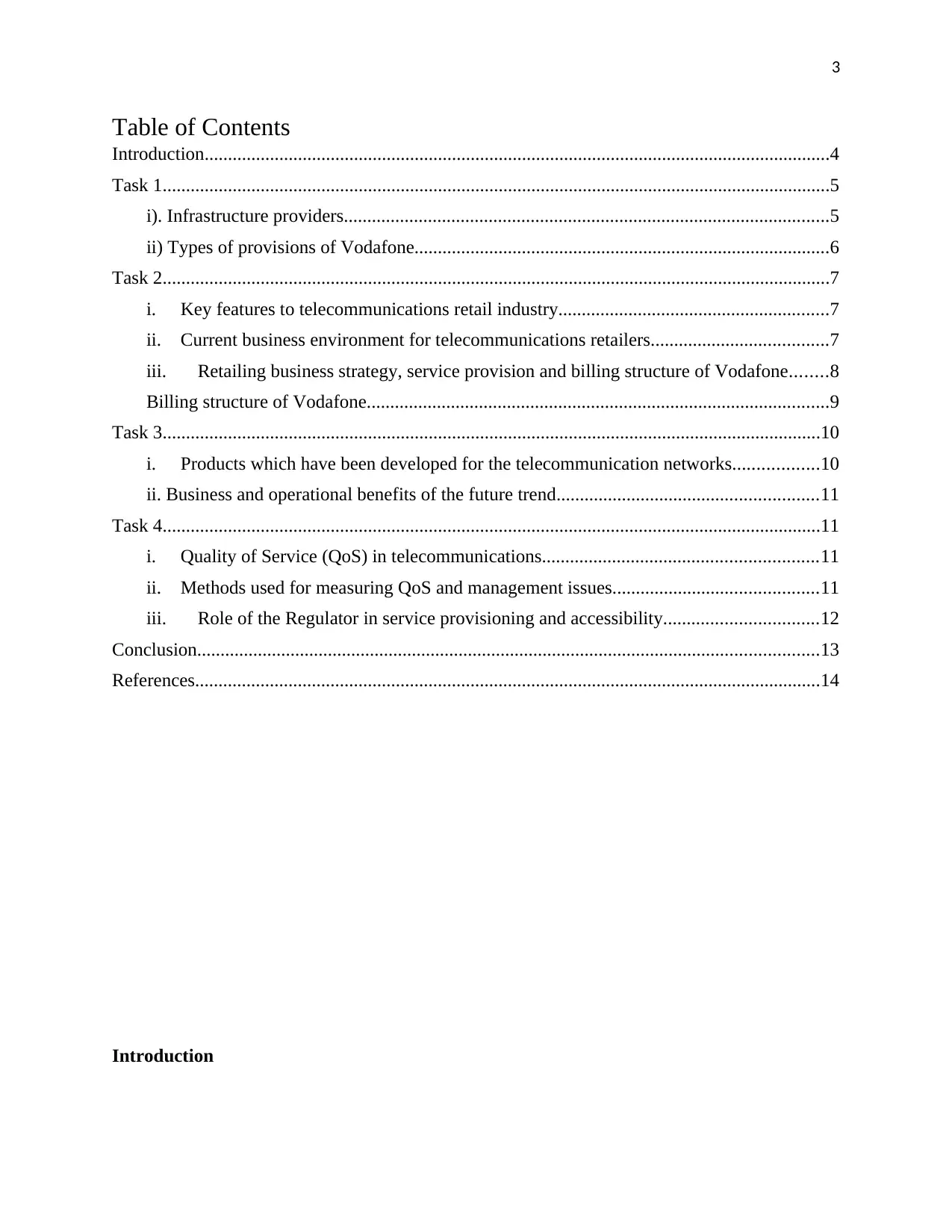
3
Table of Contents
Introduction......................................................................................................................................4
Task 1...............................................................................................................................................5
i). Infrastructure providers........................................................................................................5
ii) Types of provisions of Vodafone.........................................................................................6
Task 2...............................................................................................................................................7
i. Key features to telecommunications retail industry..........................................................7
ii. Current business environment for telecommunications retailers......................................7
iii. Retailing business strategy, service provision and billing structure of Vodafone........8
Billing structure of Vodafone...................................................................................................9
Task 3.............................................................................................................................................10
i. Products which have been developed for the telecommunication networks..................10
ii. Business and operational benefits of the future trend........................................................11
Task 4.............................................................................................................................................11
i. Quality of Service (QoS) in telecommunications...........................................................11
ii. Methods used for measuring QoS and management issues............................................11
iii. Role of the Regulator in service provisioning and accessibility.................................12
Conclusion.....................................................................................................................................13
References......................................................................................................................................14
Introduction
Table of Contents
Introduction......................................................................................................................................4
Task 1...............................................................................................................................................5
i). Infrastructure providers........................................................................................................5
ii) Types of provisions of Vodafone.........................................................................................6
Task 2...............................................................................................................................................7
i. Key features to telecommunications retail industry..........................................................7
ii. Current business environment for telecommunications retailers......................................7
iii. Retailing business strategy, service provision and billing structure of Vodafone........8
Billing structure of Vodafone...................................................................................................9
Task 3.............................................................................................................................................10
i. Products which have been developed for the telecommunication networks..................10
ii. Business and operational benefits of the future trend........................................................11
Task 4.............................................................................................................................................11
i. Quality of Service (QoS) in telecommunications...........................................................11
ii. Methods used for measuring QoS and management issues............................................11
iii. Role of the Regulator in service provisioning and accessibility.................................12
Conclusion.....................................................................................................................................13
References......................................................................................................................................14
Introduction
⊘ This is a preview!⊘
Do you want full access?
Subscribe today to unlock all pages.

Trusted by 1+ million students worldwide
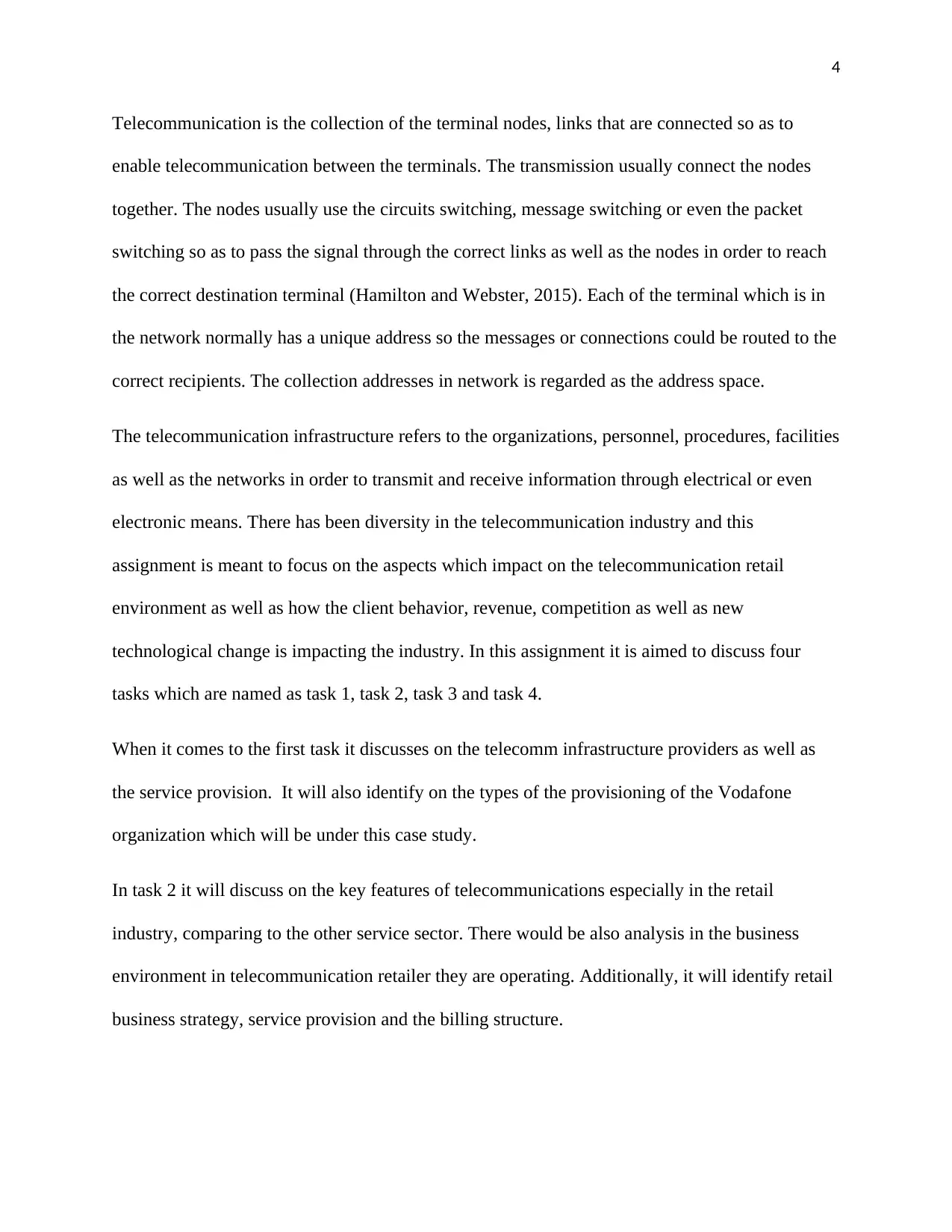
4
Telecommunication is the collection of the terminal nodes, links that are connected so as to
enable telecommunication between the terminals. The transmission usually connect the nodes
together. The nodes usually use the circuits switching, message switching or even the packet
switching so as to pass the signal through the correct links as well as the nodes in order to reach
the correct destination terminal (Hamilton and Webster, 2015). Each of the terminal which is in
the network normally has a unique address so the messages or connections could be routed to the
correct recipients. The collection addresses in network is regarded as the address space.
The telecommunication infrastructure refers to the organizations, personnel, procedures, facilities
as well as the networks in order to transmit and receive information through electrical or even
electronic means. There has been diversity in the telecommunication industry and this
assignment is meant to focus on the aspects which impact on the telecommunication retail
environment as well as how the client behavior, revenue, competition as well as new
technological change is impacting the industry. In this assignment it is aimed to discuss four
tasks which are named as task 1, task 2, task 3 and task 4.
When it comes to the first task it discusses on the telecomm infrastructure providers as well as
the service provision. It will also identify on the types of the provisioning of the Vodafone
organization which will be under this case study.
In task 2 it will discuss on the key features of telecommunications especially in the retail
industry, comparing to the other service sector. There would be also analysis in the business
environment in telecommunication retailer they are operating. Additionally, it will identify retail
business strategy, service provision and the billing structure.
Telecommunication is the collection of the terminal nodes, links that are connected so as to
enable telecommunication between the terminals. The transmission usually connect the nodes
together. The nodes usually use the circuits switching, message switching or even the packet
switching so as to pass the signal through the correct links as well as the nodes in order to reach
the correct destination terminal (Hamilton and Webster, 2015). Each of the terminal which is in
the network normally has a unique address so the messages or connections could be routed to the
correct recipients. The collection addresses in network is regarded as the address space.
The telecommunication infrastructure refers to the organizations, personnel, procedures, facilities
as well as the networks in order to transmit and receive information through electrical or even
electronic means. There has been diversity in the telecommunication industry and this
assignment is meant to focus on the aspects which impact on the telecommunication retail
environment as well as how the client behavior, revenue, competition as well as new
technological change is impacting the industry. In this assignment it is aimed to discuss four
tasks which are named as task 1, task 2, task 3 and task 4.
When it comes to the first task it discusses on the telecomm infrastructure providers as well as
the service provision. It will also identify on the types of the provisioning of the Vodafone
organization which will be under this case study.
In task 2 it will discuss on the key features of telecommunications especially in the retail
industry, comparing to the other service sector. There would be also analysis in the business
environment in telecommunication retailer they are operating. Additionally, it will identify retail
business strategy, service provision and the billing structure.
Paraphrase This Document
Need a fresh take? Get an instant paraphrase of this document with our AI Paraphraser
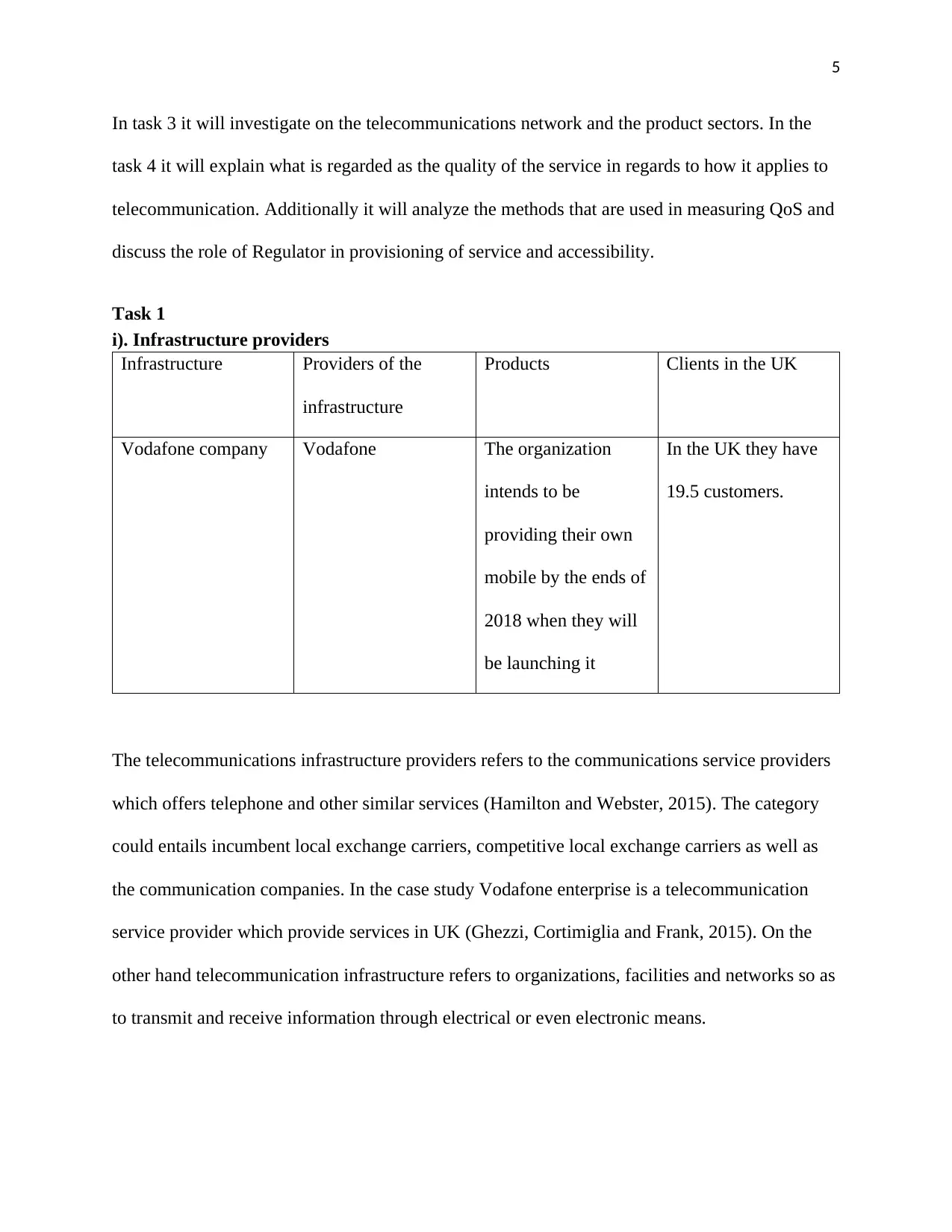
5
In task 3 it will investigate on the telecommunications network and the product sectors. In the
task 4 it will explain what is regarded as the quality of the service in regards to how it applies to
telecommunication. Additionally it will analyze the methods that are used in measuring QoS and
discuss the role of Regulator in provisioning of service and accessibility.
Task 1
i). Infrastructure providers
Infrastructure Providers of the
infrastructure
Products Clients in the UK
Vodafone company Vodafone The organization
intends to be
providing their own
mobile by the ends of
2018 when they will
be launching it
In the UK they have
19.5 customers.
The telecommunications infrastructure providers refers to the communications service providers
which offers telephone and other similar services (Hamilton and Webster, 2015). The category
could entails incumbent local exchange carriers, competitive local exchange carriers as well as
the communication companies. In the case study Vodafone enterprise is a telecommunication
service provider which provide services in UK (Ghezzi, Cortimiglia and Frank, 2015). On the
other hand telecommunication infrastructure refers to organizations, facilities and networks so as
to transmit and receive information through electrical or even electronic means.
In task 3 it will investigate on the telecommunications network and the product sectors. In the
task 4 it will explain what is regarded as the quality of the service in regards to how it applies to
telecommunication. Additionally it will analyze the methods that are used in measuring QoS and
discuss the role of Regulator in provisioning of service and accessibility.
Task 1
i). Infrastructure providers
Infrastructure Providers of the
infrastructure
Products Clients in the UK
Vodafone company Vodafone The organization
intends to be
providing their own
mobile by the ends of
2018 when they will
be launching it
In the UK they have
19.5 customers.
The telecommunications infrastructure providers refers to the communications service providers
which offers telephone and other similar services (Hamilton and Webster, 2015). The category
could entails incumbent local exchange carriers, competitive local exchange carriers as well as
the communication companies. In the case study Vodafone enterprise is a telecommunication
service provider which provide services in UK (Ghezzi, Cortimiglia and Frank, 2015). On the
other hand telecommunication infrastructure refers to organizations, facilities and networks so as
to transmit and receive information through electrical or even electronic means.
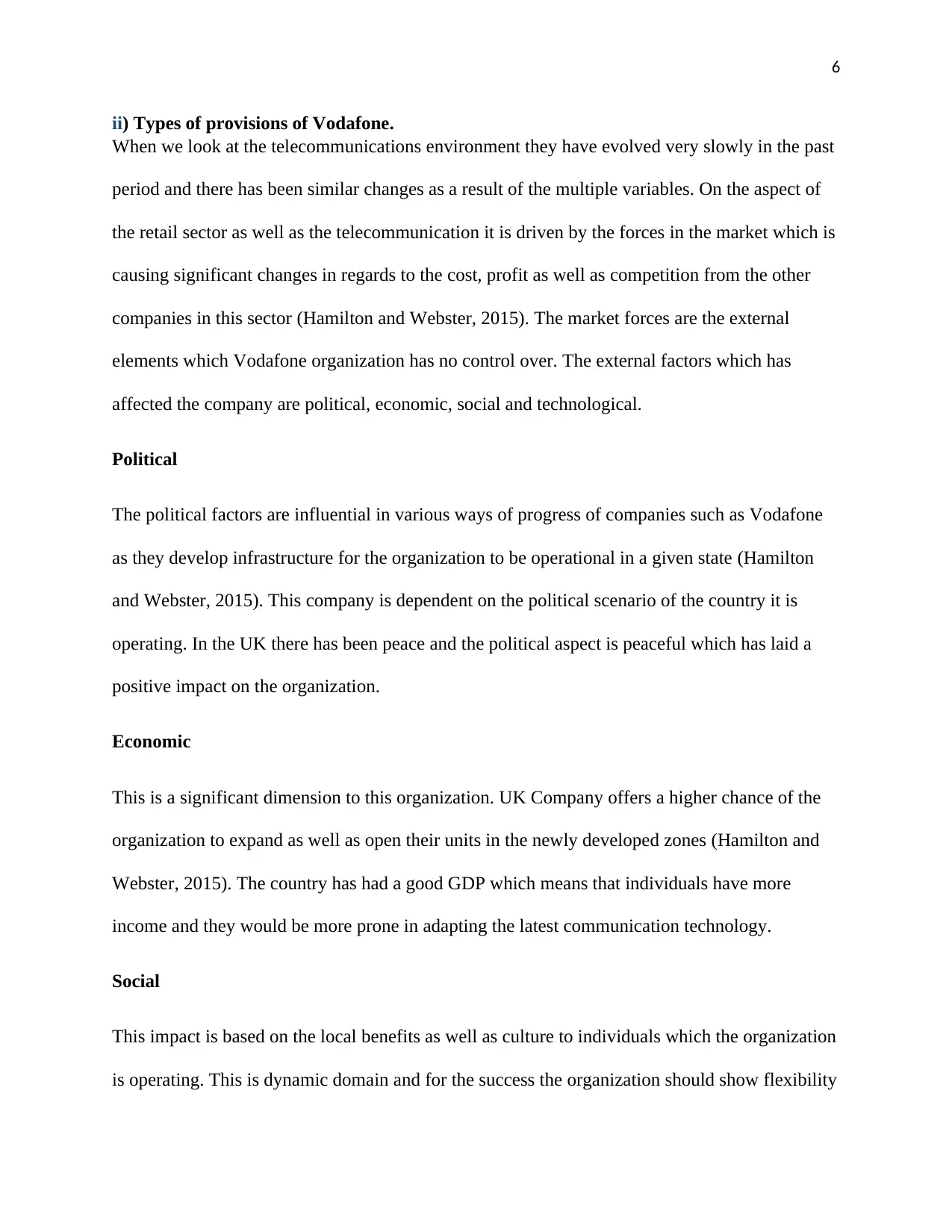
6
ii) Types of provisions of Vodafone.
When we look at the telecommunications environment they have evolved very slowly in the past
period and there has been similar changes as a result of the multiple variables. On the aspect of
the retail sector as well as the telecommunication it is driven by the forces in the market which is
causing significant changes in regards to the cost, profit as well as competition from the other
companies in this sector (Hamilton and Webster, 2015). The market forces are the external
elements which Vodafone organization has no control over. The external factors which has
affected the company are political, economic, social and technological.
Political
The political factors are influential in various ways of progress of companies such as Vodafone
as they develop infrastructure for the organization to be operational in a given state (Hamilton
and Webster, 2015). This company is dependent on the political scenario of the country it is
operating. In the UK there has been peace and the political aspect is peaceful which has laid a
positive impact on the organization.
Economic
This is a significant dimension to this organization. UK Company offers a higher chance of the
organization to expand as well as open their units in the newly developed zones (Hamilton and
Webster, 2015). The country has had a good GDP which means that individuals have more
income and they would be more prone in adapting the latest communication technology.
Social
This impact is based on the local benefits as well as culture to individuals which the organization
is operating. This is dynamic domain and for the success the organization should show flexibility
ii) Types of provisions of Vodafone.
When we look at the telecommunications environment they have evolved very slowly in the past
period and there has been similar changes as a result of the multiple variables. On the aspect of
the retail sector as well as the telecommunication it is driven by the forces in the market which is
causing significant changes in regards to the cost, profit as well as competition from the other
companies in this sector (Hamilton and Webster, 2015). The market forces are the external
elements which Vodafone organization has no control over. The external factors which has
affected the company are political, economic, social and technological.
Political
The political factors are influential in various ways of progress of companies such as Vodafone
as they develop infrastructure for the organization to be operational in a given state (Hamilton
and Webster, 2015). This company is dependent on the political scenario of the country it is
operating. In the UK there has been peace and the political aspect is peaceful which has laid a
positive impact on the organization.
Economic
This is a significant dimension to this organization. UK Company offers a higher chance of the
organization to expand as well as open their units in the newly developed zones (Hamilton and
Webster, 2015). The country has had a good GDP which means that individuals have more
income and they would be more prone in adapting the latest communication technology.
Social
This impact is based on the local benefits as well as culture to individuals which the organization
is operating. This is dynamic domain and for the success the organization should show flexibility
⊘ This is a preview!⊘
Do you want full access?
Subscribe today to unlock all pages.

Trusted by 1+ million students worldwide
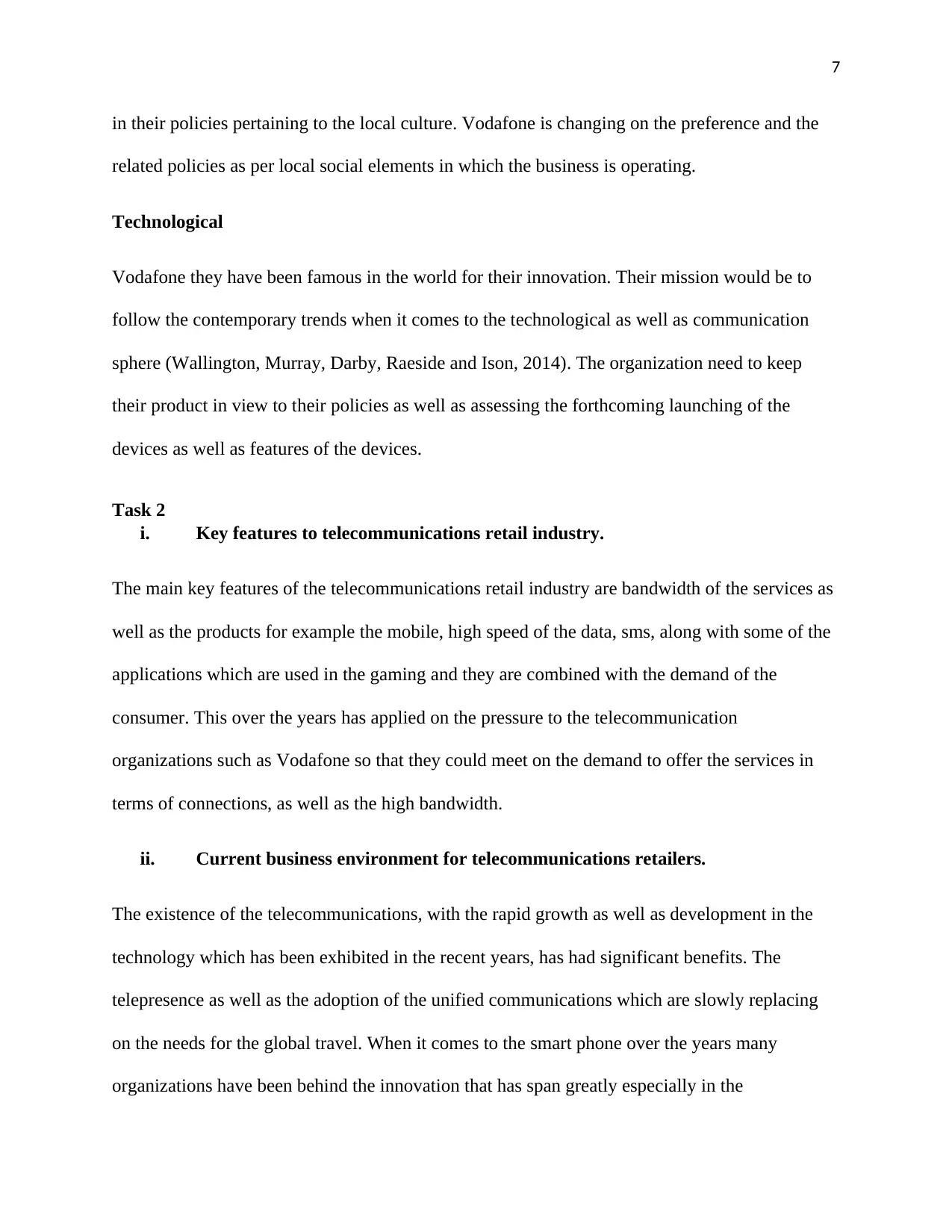
7
in their policies pertaining to the local culture. Vodafone is changing on the preference and the
related policies as per local social elements in which the business is operating.
Technological
Vodafone they have been famous in the world for their innovation. Their mission would be to
follow the contemporary trends when it comes to the technological as well as communication
sphere (Wallington, Murray, Darby, Raeside and Ison, 2014). The organization need to keep
their product in view to their policies as well as assessing the forthcoming launching of the
devices as well as features of the devices.
Task 2
i. Key features to telecommunications retail industry.
The main key features of the telecommunications retail industry are bandwidth of the services as
well as the products for example the mobile, high speed of the data, sms, along with some of the
applications which are used in the gaming and they are combined with the demand of the
consumer. This over the years has applied on the pressure to the telecommunication
organizations such as Vodafone so that they could meet on the demand to offer the services in
terms of connections, as well as the high bandwidth.
ii. Current business environment for telecommunications retailers.
The existence of the telecommunications, with the rapid growth as well as development in the
technology which has been exhibited in the recent years, has had significant benefits. The
telepresence as well as the adoption of the unified communications which are slowly replacing
on the needs for the global travel. When it comes to the smart phone over the years many
organizations have been behind the innovation that has span greatly especially in the
in their policies pertaining to the local culture. Vodafone is changing on the preference and the
related policies as per local social elements in which the business is operating.
Technological
Vodafone they have been famous in the world for their innovation. Their mission would be to
follow the contemporary trends when it comes to the technological as well as communication
sphere (Wallington, Murray, Darby, Raeside and Ison, 2014). The organization need to keep
their product in view to their policies as well as assessing the forthcoming launching of the
devices as well as features of the devices.
Task 2
i. Key features to telecommunications retail industry.
The main key features of the telecommunications retail industry are bandwidth of the services as
well as the products for example the mobile, high speed of the data, sms, along with some of the
applications which are used in the gaming and they are combined with the demand of the
consumer. This over the years has applied on the pressure to the telecommunication
organizations such as Vodafone so that they could meet on the demand to offer the services in
terms of connections, as well as the high bandwidth.
ii. Current business environment for telecommunications retailers.
The existence of the telecommunications, with the rapid growth as well as development in the
technology which has been exhibited in the recent years, has had significant benefits. The
telepresence as well as the adoption of the unified communications which are slowly replacing
on the needs for the global travel. When it comes to the smart phone over the years many
organizations have been behind the innovation that has span greatly especially in the
Paraphrase This Document
Need a fresh take? Get an instant paraphrase of this document with our AI Paraphraser
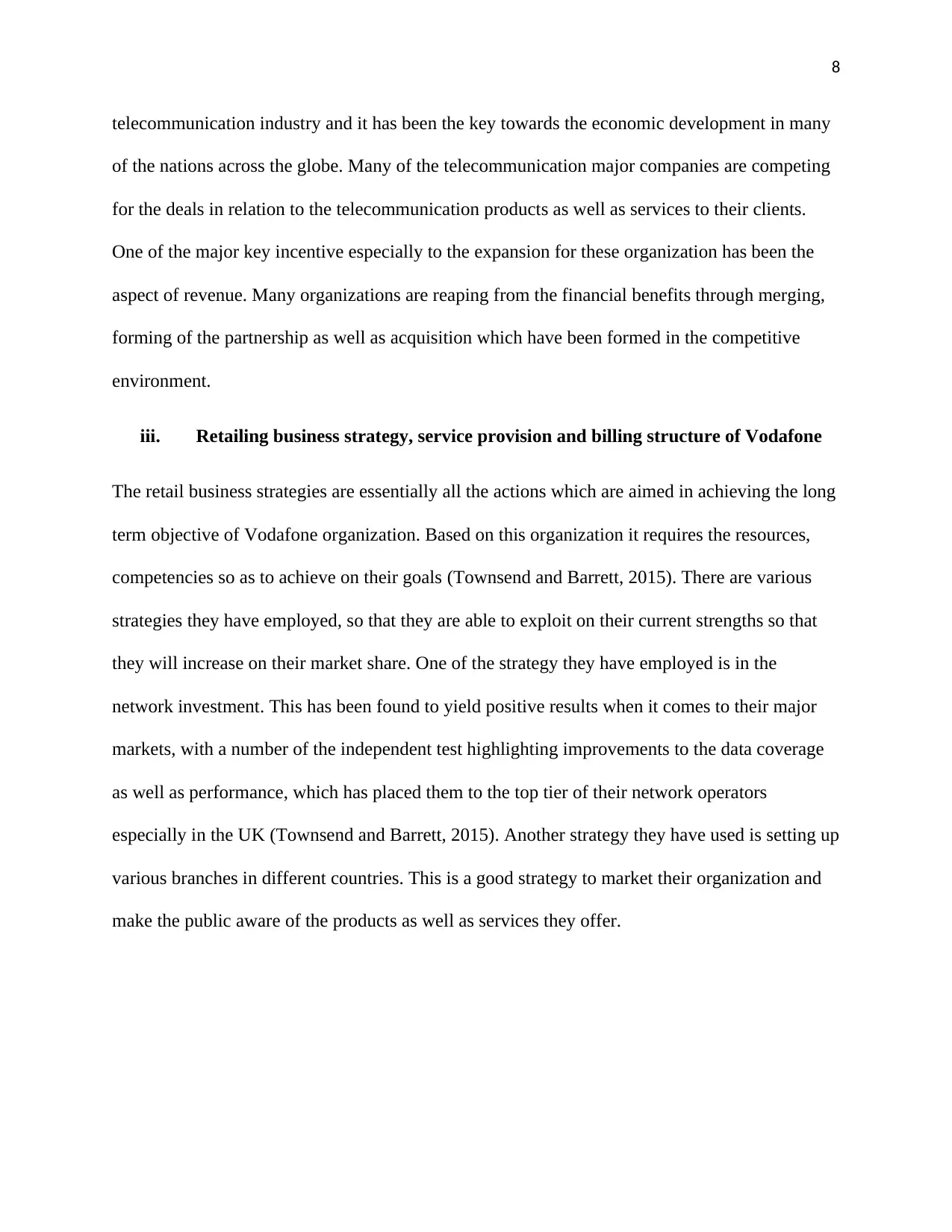
8
telecommunication industry and it has been the key towards the economic development in many
of the nations across the globe. Many of the telecommunication major companies are competing
for the deals in relation to the telecommunication products as well as services to their clients.
One of the major key incentive especially to the expansion for these organization has been the
aspect of revenue. Many organizations are reaping from the financial benefits through merging,
forming of the partnership as well as acquisition which have been formed in the competitive
environment.
iii. Retailing business strategy, service provision and billing structure of Vodafone
The retail business strategies are essentially all the actions which are aimed in achieving the long
term objective of Vodafone organization. Based on this organization it requires the resources,
competencies so as to achieve on their goals (Townsend and Barrett, 2015). There are various
strategies they have employed, so that they are able to exploit on their current strengths so that
they will increase on their market share. One of the strategy they have employed is in the
network investment. This has been found to yield positive results when it comes to their major
markets, with a number of the independent test highlighting improvements to the data coverage
as well as performance, which has placed them to the top tier of their network operators
especially in the UK (Townsend and Barrett, 2015). Another strategy they have used is setting up
various branches in different countries. This is a good strategy to market their organization and
make the public aware of the products as well as services they offer.
telecommunication industry and it has been the key towards the economic development in many
of the nations across the globe. Many of the telecommunication major companies are competing
for the deals in relation to the telecommunication products as well as services to their clients.
One of the major key incentive especially to the expansion for these organization has been the
aspect of revenue. Many organizations are reaping from the financial benefits through merging,
forming of the partnership as well as acquisition which have been formed in the competitive
environment.
iii. Retailing business strategy, service provision and billing structure of Vodafone
The retail business strategies are essentially all the actions which are aimed in achieving the long
term objective of Vodafone organization. Based on this organization it requires the resources,
competencies so as to achieve on their goals (Townsend and Barrett, 2015). There are various
strategies they have employed, so that they are able to exploit on their current strengths so that
they will increase on their market share. One of the strategy they have employed is in the
network investment. This has been found to yield positive results when it comes to their major
markets, with a number of the independent test highlighting improvements to the data coverage
as well as performance, which has placed them to the top tier of their network operators
especially in the UK (Townsend and Barrett, 2015). Another strategy they have used is setting up
various branches in different countries. This is a good strategy to market their organization and
make the public aware of the products as well as services they offer.
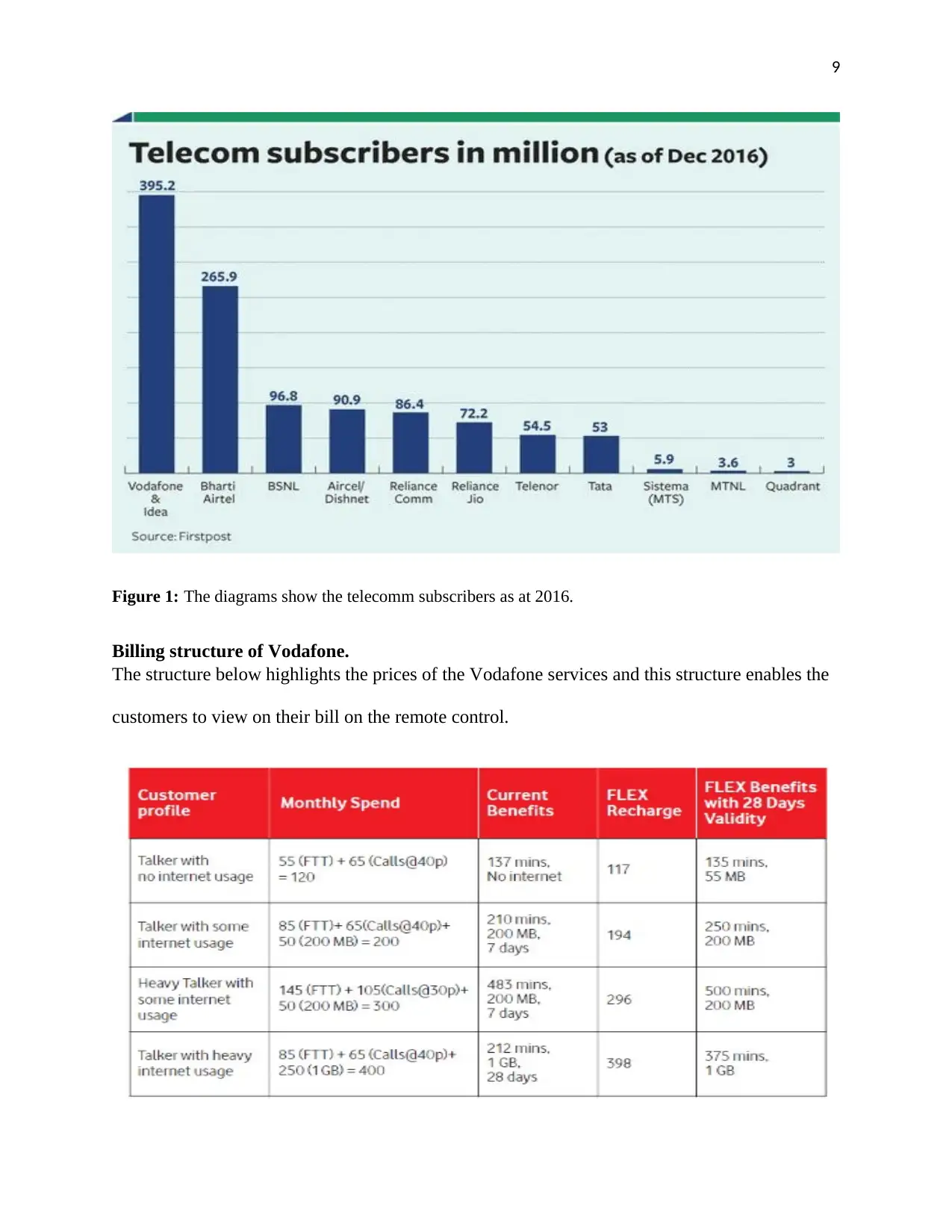
9
Figure 1: The diagrams show the telecomm subscribers as at 2016.
Billing structure of Vodafone.
The structure below highlights the prices of the Vodafone services and this structure enables the
customers to view on their bill on the remote control.
Figure 1: The diagrams show the telecomm subscribers as at 2016.
Billing structure of Vodafone.
The structure below highlights the prices of the Vodafone services and this structure enables the
customers to view on their bill on the remote control.
⊘ This is a preview!⊘
Do you want full access?
Subscribe today to unlock all pages.

Trusted by 1+ million students worldwide
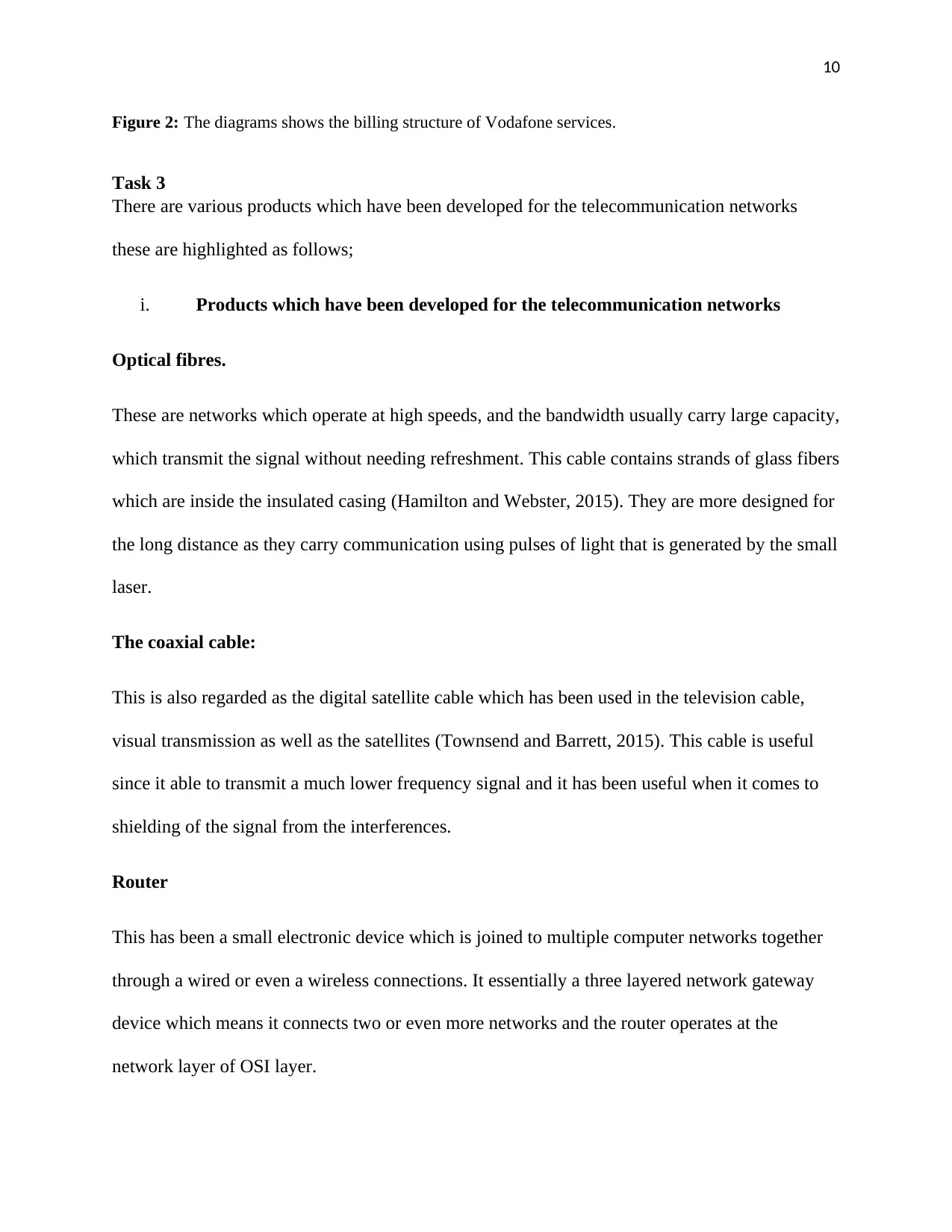
10
Figure 2: The diagrams shows the billing structure of Vodafone services.
Task 3
There are various products which have been developed for the telecommunication networks
these are highlighted as follows;
i. Products which have been developed for the telecommunication networks
Optical fibres.
These are networks which operate at high speeds, and the bandwidth usually carry large capacity,
which transmit the signal without needing refreshment. This cable contains strands of glass fibers
which are inside the insulated casing (Hamilton and Webster, 2015). They are more designed for
the long distance as they carry communication using pulses of light that is generated by the small
laser.
The coaxial cable:
This is also regarded as the digital satellite cable which has been used in the television cable,
visual transmission as well as the satellites (Townsend and Barrett, 2015). This cable is useful
since it able to transmit a much lower frequency signal and it has been useful when it comes to
shielding of the signal from the interferences.
Router
This has been a small electronic device which is joined to multiple computer networks together
through a wired or even a wireless connections. It essentially a three layered network gateway
device which means it connects two or even more networks and the router operates at the
network layer of OSI layer.
Figure 2: The diagrams shows the billing structure of Vodafone services.
Task 3
There are various products which have been developed for the telecommunication networks
these are highlighted as follows;
i. Products which have been developed for the telecommunication networks
Optical fibres.
These are networks which operate at high speeds, and the bandwidth usually carry large capacity,
which transmit the signal without needing refreshment. This cable contains strands of glass fibers
which are inside the insulated casing (Hamilton and Webster, 2015). They are more designed for
the long distance as they carry communication using pulses of light that is generated by the small
laser.
The coaxial cable:
This is also regarded as the digital satellite cable which has been used in the television cable,
visual transmission as well as the satellites (Townsend and Barrett, 2015). This cable is useful
since it able to transmit a much lower frequency signal and it has been useful when it comes to
shielding of the signal from the interferences.
Router
This has been a small electronic device which is joined to multiple computer networks together
through a wired or even a wireless connections. It essentially a three layered network gateway
device which means it connects two or even more networks and the router operates at the
network layer of OSI layer.
Paraphrase This Document
Need a fresh take? Get an instant paraphrase of this document with our AI Paraphraser
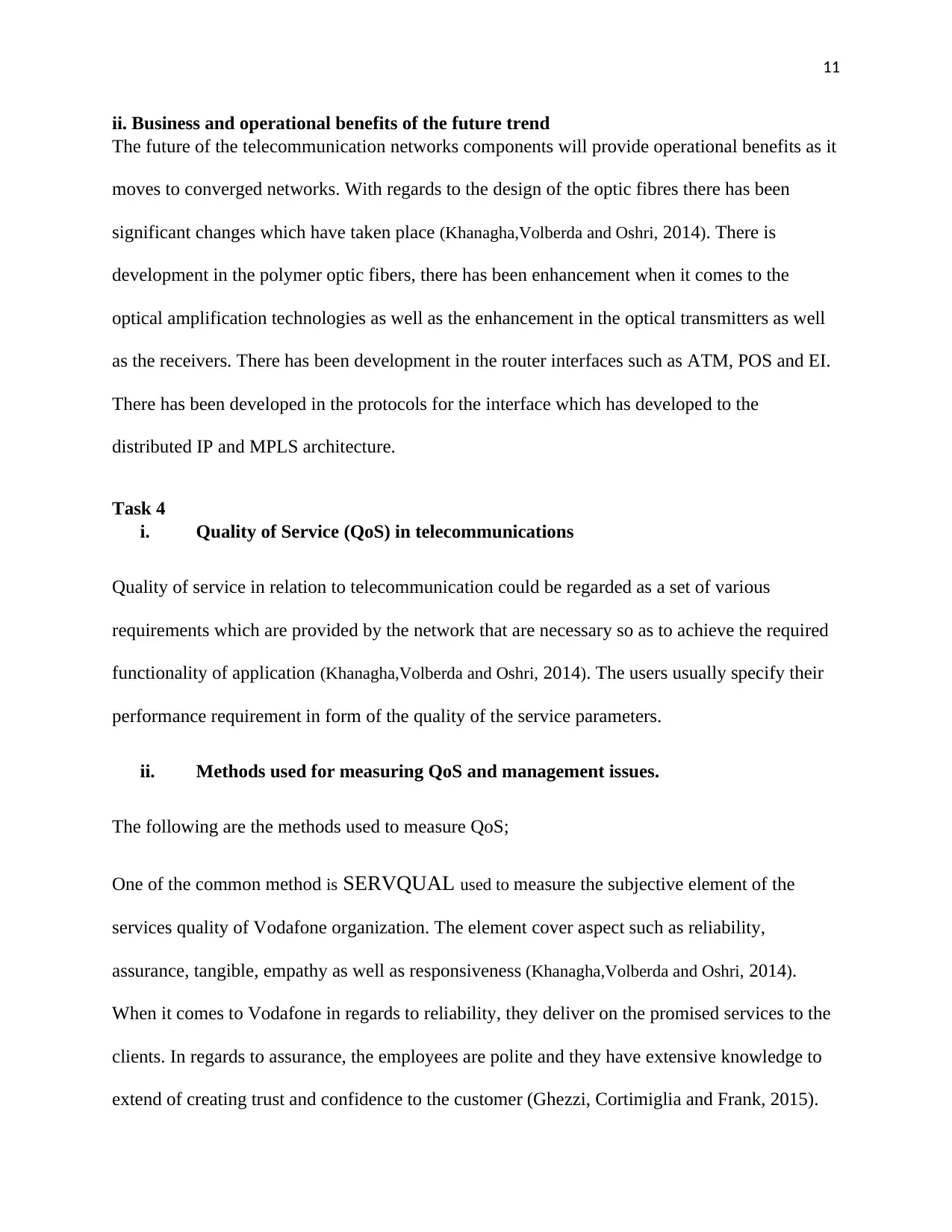
11
ii. Business and operational benefits of the future trend
The future of the telecommunication networks components will provide operational benefits as it
moves to converged networks. With regards to the design of the optic fibres there has been
significant changes which have taken place (Khanagha,Volberda and Oshri, 2014). There is
development in the polymer optic fibers, there has been enhancement when it comes to the
optical amplification technologies as well as the enhancement in the optical transmitters as well
as the receivers. There has been development in the router interfaces such as ATM, POS and EI.
There has been developed in the protocols for the interface which has developed to the
distributed IP and MPLS architecture.
Task 4
i. Quality of Service (QoS) in telecommunications
Quality of service in relation to telecommunication could be regarded as a set of various
requirements which are provided by the network that are necessary so as to achieve the required
functionality of application (Khanagha,Volberda and Oshri, 2014). The users usually specify their
performance requirement in form of the quality of the service parameters.
ii. Methods used for measuring QoS and management issues.
The following are the methods used to measure QoS;
One of the common method is SERVQUAL used to measure the subjective element of the
services quality of Vodafone organization. The element cover aspect such as reliability,
assurance, tangible, empathy as well as responsiveness (Khanagha,Volberda and Oshri, 2014).
When it comes to Vodafone in regards to reliability, they deliver on the promised services to the
clients. In regards to assurance, the employees are polite and they have extensive knowledge to
extend of creating trust and confidence to the customer (Ghezzi, Cortimiglia and Frank, 2015).
ii. Business and operational benefits of the future trend
The future of the telecommunication networks components will provide operational benefits as it
moves to converged networks. With regards to the design of the optic fibres there has been
significant changes which have taken place (Khanagha,Volberda and Oshri, 2014). There is
development in the polymer optic fibers, there has been enhancement when it comes to the
optical amplification technologies as well as the enhancement in the optical transmitters as well
as the receivers. There has been development in the router interfaces such as ATM, POS and EI.
There has been developed in the protocols for the interface which has developed to the
distributed IP and MPLS architecture.
Task 4
i. Quality of Service (QoS) in telecommunications
Quality of service in relation to telecommunication could be regarded as a set of various
requirements which are provided by the network that are necessary so as to achieve the required
functionality of application (Khanagha,Volberda and Oshri, 2014). The users usually specify their
performance requirement in form of the quality of the service parameters.
ii. Methods used for measuring QoS and management issues.
The following are the methods used to measure QoS;
One of the common method is SERVQUAL used to measure the subjective element of the
services quality of Vodafone organization. The element cover aspect such as reliability,
assurance, tangible, empathy as well as responsiveness (Khanagha,Volberda and Oshri, 2014).
When it comes to Vodafone in regards to reliability, they deliver on the promised services to the
clients. In regards to assurance, the employees are polite and they have extensive knowledge to
extend of creating trust and confidence to the customer (Ghezzi, Cortimiglia and Frank, 2015).
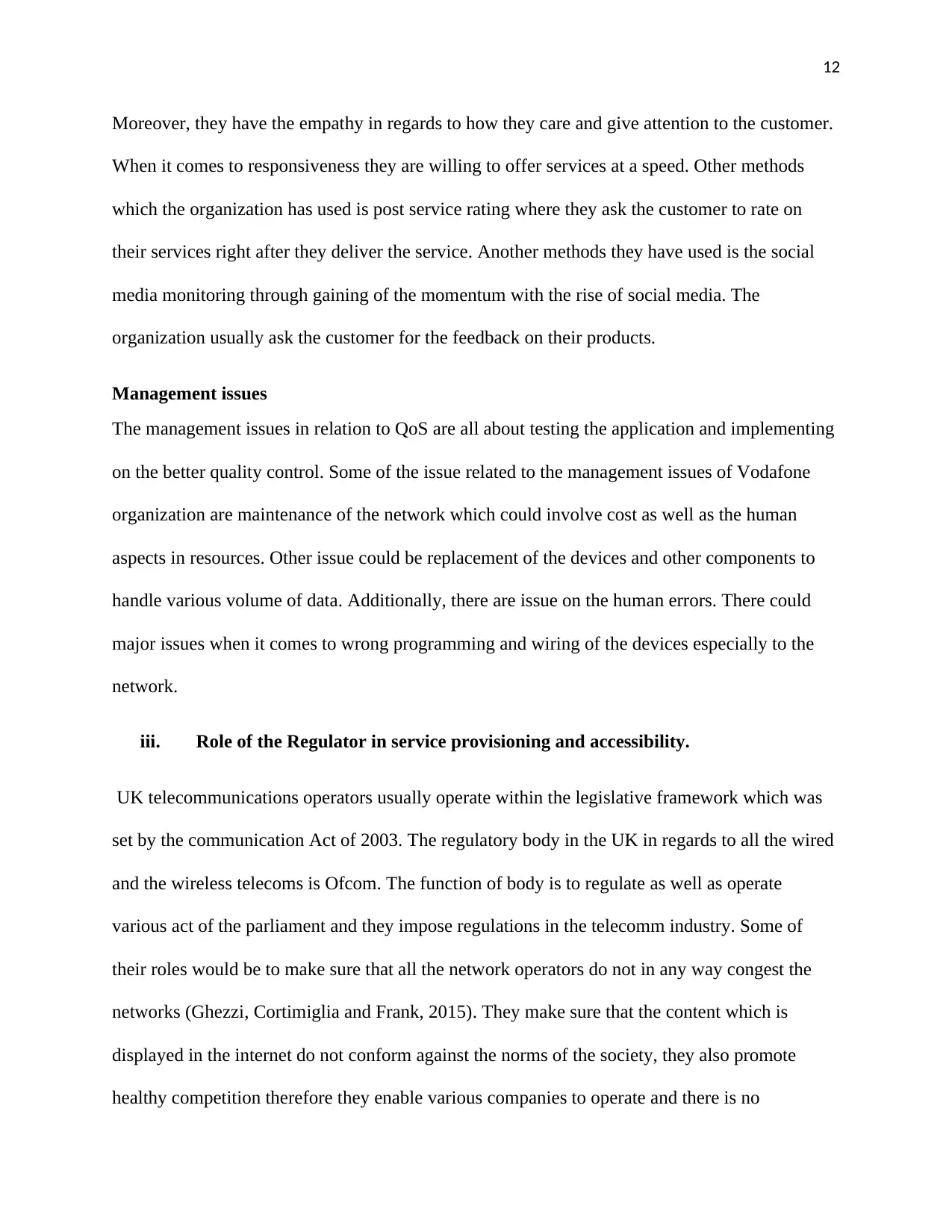
12
Moreover, they have the empathy in regards to how they care and give attention to the customer.
When it comes to responsiveness they are willing to offer services at a speed. Other methods
which the organization has used is post service rating where they ask the customer to rate on
their services right after they deliver the service. Another methods they have used is the social
media monitoring through gaining of the momentum with the rise of social media. The
organization usually ask the customer for the feedback on their products.
Management issues
The management issues in relation to QoS are all about testing the application and implementing
on the better quality control. Some of the issue related to the management issues of Vodafone
organization are maintenance of the network which could involve cost as well as the human
aspects in resources. Other issue could be replacement of the devices and other components to
handle various volume of data. Additionally, there are issue on the human errors. There could
major issues when it comes to wrong programming and wiring of the devices especially to the
network.
iii. Role of the Regulator in service provisioning and accessibility.
UK telecommunications operators usually operate within the legislative framework which was
set by the communication Act of 2003. The regulatory body in the UK in regards to all the wired
and the wireless telecoms is Ofcom. The function of body is to regulate as well as operate
various act of the parliament and they impose regulations in the telecomm industry. Some of
their roles would be to make sure that all the network operators do not in any way congest the
networks (Ghezzi, Cortimiglia and Frank, 2015). They make sure that the content which is
displayed in the internet do not conform against the norms of the society, they also promote
healthy competition therefore they enable various companies to operate and there is no
Moreover, they have the empathy in regards to how they care and give attention to the customer.
When it comes to responsiveness they are willing to offer services at a speed. Other methods
which the organization has used is post service rating where they ask the customer to rate on
their services right after they deliver the service. Another methods they have used is the social
media monitoring through gaining of the momentum with the rise of social media. The
organization usually ask the customer for the feedback on their products.
Management issues
The management issues in relation to QoS are all about testing the application and implementing
on the better quality control. Some of the issue related to the management issues of Vodafone
organization are maintenance of the network which could involve cost as well as the human
aspects in resources. Other issue could be replacement of the devices and other components to
handle various volume of data. Additionally, there are issue on the human errors. There could
major issues when it comes to wrong programming and wiring of the devices especially to the
network.
iii. Role of the Regulator in service provisioning and accessibility.
UK telecommunications operators usually operate within the legislative framework which was
set by the communication Act of 2003. The regulatory body in the UK in regards to all the wired
and the wireless telecoms is Ofcom. The function of body is to regulate as well as operate
various act of the parliament and they impose regulations in the telecomm industry. Some of
their roles would be to make sure that all the network operators do not in any way congest the
networks (Ghezzi, Cortimiglia and Frank, 2015). They make sure that the content which is
displayed in the internet do not conform against the norms of the society, they also promote
healthy competition therefore they enable various companies to operate and there is no
⊘ This is a preview!⊘
Do you want full access?
Subscribe today to unlock all pages.

Trusted by 1+ million students worldwide
1 out of 14
Related Documents
Your All-in-One AI-Powered Toolkit for Academic Success.
+13062052269
info@desklib.com
Available 24*7 on WhatsApp / Email
![[object Object]](/_next/static/media/star-bottom.7253800d.svg)
Unlock your academic potential
Copyright © 2020–2025 A2Z Services. All Rights Reserved. Developed and managed by ZUCOL.



